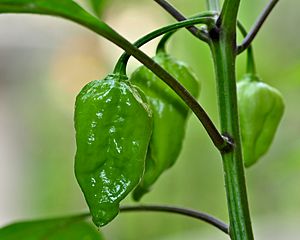Scoville scale facts for kids
The Scoville scale measures how spicy or "hot" chili peppers are. This spiciness is called pungency. The scale uses units called Scoville Heat Units (SHU). These units tell us how much of a chemical called capsaicin is in the pepper. Capsaicin is the main thing that makes peppers feel hot.
The scale is named after an American pharmacist, Wilbur Scoville. He created his method in 1912. It was called the Scoville organoleptic test. This test relied on people tasting diluted pepper extracts. They would say when they could no longer feel the heat.
Today, scientists use a more accurate method. It's called high-performance liquid chromatography (HPLC). This method measures the exact amount of capsaicin in a pepper. It gives a more reliable spiciness rating.
Contents
How We Measure Spice
The Original Taste Test
Wilbur Scoville's original test was a taste test. First, he would dry a pepper and dissolve it in alcohol. This extracted the spicy chemicals. Then, he would dilute this spicy liquid in sugar water.
A group of five trained tasters would try different dilutions. They would keep tasting until most of them (at least three) could no longer feel the heat. The spiciness level was based on how much the extract had to be diluted. This was then rated in multiples of 100 SHU.
This taste test had some problems. Everyone tastes things a little differently. Some people are more sensitive to spice than others. Also, after tasting a few spicy samples, people's mouths get tired. This makes it harder to taste the heat accurately. Because of these reasons, results could vary a lot between different tests.
Modern Spice Measurement
Since the 1980s, scientists have used a better way to measure spice. It's called high-performance liquid chromatography (HPLC). This method measures the exact amount of spicy chemicals, like capsaicin, in a pepper.
HPLC is much more accurate than the old taste test. It gives results that can be easily converted into Scoville Heat Units. For example, if HPLC finds a certain amount of capsaicin, it can be multiplied by 15 or 16 to get the SHU value. This way, we get a consistent and reliable measure of how hot a pepper is.
Scoville Ratings
What Affects Pepper Heat?
The Scoville rating of a pepper can change. It depends on many things. For example, how much water is in the pepper can affect its rating. Fresh peppers have a lot of water, while dried peppers have less. This means a fresh pepper and a dried version of the same pepper might seem to have different SHU values if you don't consider the water content.
Also, how a pepper is grown matters. Things like the type of seed, the climate, how much humidity there is, and the soil can all change how spicy a pepper becomes. This is why the spiciness of a pepper can vary a lot, even within the same type.
Capsicum Peppers

Capsicum peppers are chili peppers. People use them all over the world to add spice to food. The Scoville scale shows a huge range of heat for these peppers. It goes from very mild peppers with less than 500 SHU to super hot ones like the Carolina Reaper, which can be over 1.5 million SHU.
Here is a table showing the Scoville ratings for some common Capsicum peppers:
| Scoville Heat Units | Examples |
|---|---|
| 1,500,000+ | Carolina Reaper |
| 750,000–1,500,000 | Trinidad Moruga scorpion, Naga Viper pepper, Infinity chili, Ghost pepper |
| 350,000–750,000 | Red Savina pepper |
| 100,000–350,000 | Habanero chili, Scotch bonnet pepper |
| 50,000–100,000 | Bird's eye chili (also known as Thai chili pepper), Malagueta pepper |
| 25,000–50,000 | Tabasco pepper, Cayenne pepper |
| 10,000–25,000 | Serrano pepper, Aleppo pepper |
| 2,500–10,000 | Jalapeño pepper, Guajillo chili |
| 1,000–2,500 | Anaheim pepper, Poblano pepper |
| 500–1,000 | Cubanelle |
| 0–500 | Banana pepper, Pimento |
| 0 | Bell pepper |
Other Spicy Chemicals
The chemicals that make chili peppers hot are called capsaicinoids. Capsaicin is the most important one. The more capsaicinoids a pepper has, the higher its Scoville rating will be.
The Scoville scale can also be used to describe the heat of other spicy chemicals, even if they are not from peppers. For example, resiniferatoxin is a chemical found in some plants. It is incredibly hot, about 1,000 times spicier than capsaicin! This means it would have a Scoville rating of 16 billion SHU.
Here are some other spicy chemicals and their Scoville ratings:
| Scoville Heat Units | Chemical | Ref |
|---|---|---|
| 16,000,000,000 | Resiniferatoxin | |
| 5,300,000,000 | Tinyatoxin | |
| 16,000,000 | Capsaicin | |
| 15,000,000 | Dihydrocapsaicin | |
| 9,200,000 | Nonivamide | |
| 9,100,000 | Nordihydrocapsaicin | |
| 8,600,000 | Homocapsaicin, Homodihydrocapsaicin | |
| 160,000 | Shogaol | |
| 150,000 | Piperine | |
| 60,000 | Gingerol |
See also
 In Spanish: Escala Scoville para niños
In Spanish: Escala Scoville para niños





